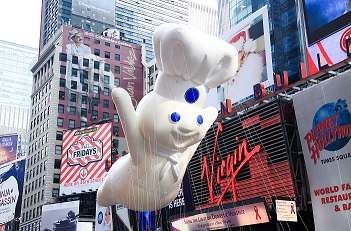Appearances are everything in the marketing world. So, when it comes to selecting a face to represent a brand, companies are wise to choose carefully.
According to a recent study by social media monitoring company Synthesio, if you’re looking to get ahead on the social media marketing bandwagon, mascots are the way to go.
It’s hard to find a consumer who isn’t enchanted by the giggle of the Pillsbury Doughboy, the GRRR-eatness of Tony the Tiger, the sophisticated British accent of Geico the Gecko, or the colorful team of M&M personalities. And as evidenced by Synthesio’s research, this charm translates into more discussion on social media than does that of celebrities in relation to the brand.

Completed between November 2012 and April 2013, the study looked at any post that mentioned both the brand and the celebrity or mascot associated with it.
Though often seen as a risky choice, channeling creative juices to mold an iconic mascot instead of selecting a celebrity to represent your brand may be the more forward-thinking, lucrative marketing technique. At least, that appears to be the case since it was demonstrated that at 22.14 percent the Pillsbury Doughboy generated more than 10 times the social media buzz as Nike endorser LeBron James at a dismal 1.73 percent.
In fact, the top five mascots, the Pillsbury Doughboy, the Aflac duck, Progressive’s Flo, Geico the Gecko and Tony the Tiger, all beat out big names like Bud Light’s Justin Timberlake, Subway’s Michael Phelps and Nikon’s Ashton Kutcher. Only four celebrities managed to produce over 1% of social media mentions of their respective brands.
The new results may have companies questioning whether they should start directing their money towards a professional creative team than a celebrity.
So, why mascots?
According to Synthesio CEO Loïc Moisand in an article by USA Today, mascots personify the company in a unique way that enables consumers to easily engage with them on social media. While celebrities like Cover Girl’s Rihanna can be associated with multiple projects, a mascot is identified solely with the brand. Moisand also said that celebrities have multiple responsibilities to fulfill through their Twitter including advertising their projects and engaging with fans, while mascots’ efforts can be dedicated 100% to brand promotion.
In the same article brand consultant Kate Newlin cites the “cuddle quotient” as the cause, saying that in contrast celebrities appear to be “rented.”
The one celebrity outlier in the research was GoDaddy’s racecar star Danica Patrick. Moisand credited this partially to Patrick’s individual style of using Twitter, often referencing GoDaddy in her tweets.
On top of everything, Moisand added in a statement, “[mascots] are popular, have no competing agendas and they work for free.”
Companies taking notice might want to take a lesson from the Keebler elves and get to work on their own irresistible icon. Synthesio did. Evidence of the study was so convincing that Moisand ordered the creation of a mascot for his own company; a ladybug aptly named Synthia.
Edited by
Carrie Schmelkin















